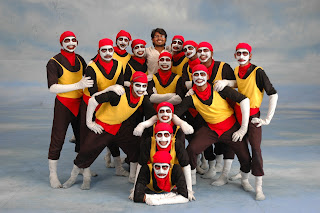Here are some of the tips on acting that i learnt from my experiences. It might be of use to you...
FIND YOUR APT LIGHT
Just like finding your mark in film, finding your light on stage is a tricky technique. Unlike film, where a mark is set up specifically for an actor, lighting in a stage production is set up more generally – to light the scene. It’s up to you to find your light. The easiest way to do this is by feeling the light on your face and in your eyes.
Stage lights are set from above, so when you step into your spot, per your blocking, feel where the light shines on you. Ideally, you should feel the heat of the light on your face and if you were to look up, you’d see the light angled at around your forehead. Be careful of standing directly under a hot light, however, as you will get “washed out” by the light’s glare.MIND YOUR VOICE
- Only drink water that is room temperature or warm. Cold water will constrict your vocal cords.
- Before a performance and between scenes, sip hot water with lemon.
- Deliver your voice by using your diaphragm, not your throat, to control your breath and vocal cords.
KNOW YOUR DIRECTIONS
Acting on stage requires the knowledge of a new kind of navigation. When you are on stage, directions are oriented to you as the actor. (Conversely, House Left (HL) and House Right (HR) refer to directions oriented to the audience.) In a script, you’ll see blocking that may read any of the following: SL, SR, DSL, DSR, USL, USD. Here’s what they mean:
SL: Stage Left – Your left when you are standing on stage.
DSL: Downstage Left – Moving toward the audience, to your left.
DSR: Downstage Right – Moving toward audience to your right.
USL: Upstage Left – Moving to the back of the stage, left.
USR: Upstage Right – Moving to the back of the stage, right.
Downstage and Upstage refer to the old days of theater -- think Shakespeare -- when stages were "raked," or sloped. When you moved toward the audience you were literally moving in a downward direction and upward when you moved to the back of the stage.
STAGE ACTING TERM: BLOCKING
Blocking is the term used to describe where and how an actor moves on the stage during a play. Most playwrights incorporate basic blocking into their scripts. Since stages come in different sizes and may have different special needs, the director will draft out his/her own blocking before rehearsals begin. Blocking includes elements such as where an actor takes his place at the beginning of a scene, “crossing,” when an actor moves across the length of the stage to another actor or part of the set, and any action that asks an actor to employ the use of a prop.
In musical theatre, blocking becomes especially important, particularly when choreography is introduced. It's imperative that every actor is in the right spot on stage before and after a musical number. Oftentimes, this positioning becomes a cue for the orchestra or for other actors' entrances.
STAGE COMBAT
Stage combat, quite simply, is fighting on stage. Of course it is more complex than that. In order to stage a fight, actors must look convincingly as though they are fighting – whether hand-to-hand or with swords (generally rapiers or broadswords). Fight directors are hired to actually choreograph moves for any fight you see on stage or on screen. It’s a serious business; no one wants injuries! Once the actors learn their fight “dance,” it is up to them to bring the final element to the scene: the acting. It’s one thing to see an exciting wrestling match, punchfest, or duel, but the scene is raised to a higher level when the actors deliver the emotion of the moment with each blow.
OPEN BODY LANGUAGE
Novice actors make the mistake of “closing” themselves off to the audience. In physical terms, this means you have positioned your body on a slight diagonal so that the side facing the audience is blocking the rest of your body. This is also calling “upstaging yourself,” as you have essentially shoved half of your body upstage, toward the back of the stage. Many young actors do this unconsciously, as a way to protect themselves from the very vulnerable position of being in front of an audience.
It’s important to remain open, both physically and emotionally when you are on stage. In terms of your body positioning, always angle your body out toward the audience if you’re not facing them outright. Any movements that require you to turn, always turn in the downstage direction. If you need to cross furniture, cross in front of it whenever possible. And as every actor knows, never leave your back turned to the audience. As many directors say, “They’re paying to see your face, not your behind.”
Thanks to sft.edu for referance.






great info, will be very useful to others.
ReplyDelete